In my conversations with online merchants, Google Shopping repeatedly comes up as one of the most profitable advertising channels. Across our agency we regularly see returns of 600% and higher from this platform for our clients. Meaning for every dollar spent with Google Shopping (aka Product Listing Ads or PLAs) merchants can see $6 or more in sales.
Even a sloppy or under-optimized Google Shopping or PLA campaign is likely to return some results and sales. But who wants to settle for mediocre results when so much more is readily available?
While optimization takes ongoing work and attention, here are five keys that will set you up for success. Follow all five keys and you will be way ahead of most of your competitors.
Ultimately your goal should be twofold:
- Win the right impressions: Get your ad in front of the right shoppers.
- Win the right clicks: Get interested buyers to click on your product listing ads.
What is Google Shopping?
For anyone unfamiliar with the platform, Google Shopping consists of product listings ads that appear at the top center or top right of a Google search results page when someone searches for a product.
Let’s say you sell licensed NFL apparel. Let’s say you want to sell more Chiefs hoodies. Let’s say a prospective buyer searches in Google for “Kansas City Chiefs Hoodie.” What will determine if they click on your listing?
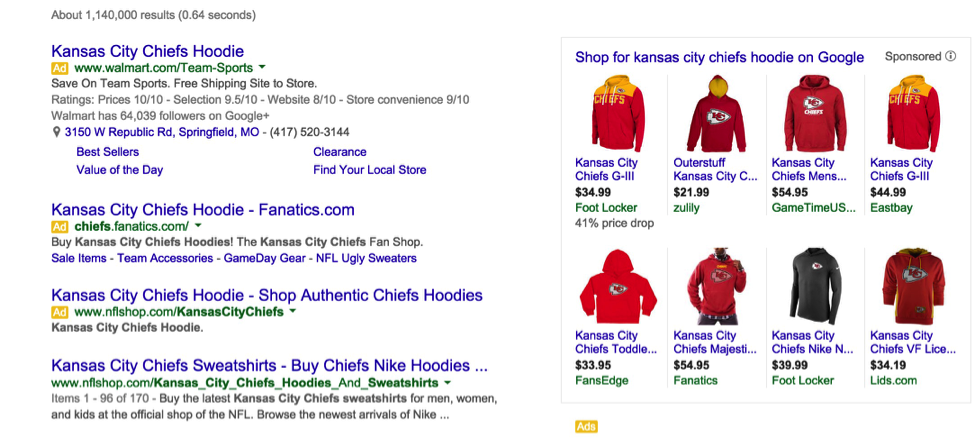
First of all you need to be a part of the initial eight listings (sometimes Google shows fewer listings). If you aren’t part of the initial eight you can still get some traffic for when people click on the “Shop for…” link above the eight ads. You really need several things working together: your data feed, bids, campaign structure, images, prices and a few other factors. You have to show up for the right searches and you need to win the click.
How Do You Run Google Shopping Ads?
To run Google Shopping Ads you need two accounts working together: Google AdWords and Google Merchant Center. Google Merchant Center is where your data feed lives. Your data feed is a collection of information about your product inventory including product title, description, price, image and several other data points formatted in a way that Google likes. Google then uses your feed to create your product ads. It also uses this data to know when to show your ads. Google Merchant Center is also where you create rules around shipping, sales tax, choose your target country and where you verify that you own your site.
Google AdWords is where your actual Shopping Campaigns live. This is where you’ll create daily budgets, bids, ad groups and product groups. It’s also one of the primary places you’ll monitor and optimize performance. We also highly recommend that you use Google Analytics to get detailed performance insights.
Google Shopping management and optimization have many similarities to good SEO. Unlike traditional text ads, you can’t explicitly specify what keywords you want your product listing ads to show for. Instead, Google crawls your feed and determines what queries or keywords your product listing ads are relevant for. That’s why it’s so important to give Google good data that it can strategically put together.
I’m going to reference how we use SEMrush to give us and our clients an edge with Google Shopping. I want to make it clear that I’m not just touting SEMrush on their blog. This is a tool we use day in and day out. I even mentioned in an article recently at Search Engine Journal that if I had to pick just one SEO (or SEM) tool, I would pick SEMrush.
Now on to the five keys. For ease of discussion, I’m going to split these five keys into three categories.
Speak to Your Customers
1. Find Buyer Keywords
While you can’t specify to Google what keywords you want to run product listing ads for, you still want to have a keyword strategy. Sometimes, okay, most of the time data is boring. When I mention data feeds most people’s eyes start to glaze over and they start fighting sleep. Think of your data feed this way. You are speaking to your customers and speaking to Google. The first point of research to help in your quest for awesome Shopping ads is to find buyer keywords.
Let’s again say that you sell licensed NFL apparel. I’m a Kansas City Chiefs fan, so let’s say you want to sell more Chief’s hoodies. You likely shouldn’t trouble yourself with researching and paying attention to keywords like “hoodie” or “red hoodie” or even “NFL hoodie.”Instead, you should think about keywords like “Kansas City Chiefs Hoodie” or “Chiefs nike hoodie.” As a rule of thumb, keywords that show buyer intent are often three words or longer and include specifics like color, brand, size, model number, etc.
Where should you start? Type in your buyer keywords to SEMrush and look for lists of phrase match and related keywords. Take note of those that seem to indicate proper intent and that also have decent search volume.
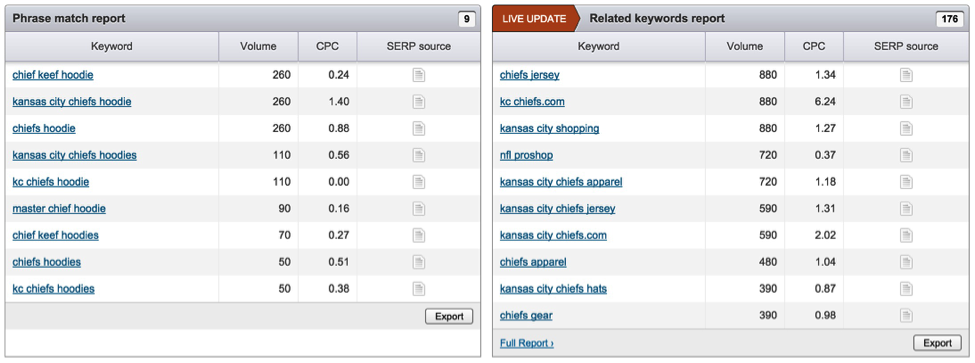
Trump Your Competition
2. Title Benchmarking
You have two goals with your product title: rankings and clicks.
You first want Google to crawl your product titles and find you relevant for top buyer keywords. Then you want potential buyers to click on your listing ad over your competitors. Your product titles are arguably the most important factors in determining the keywords your PLAs show for. Getting this right is critical for your long term impressions and clicks. Admittedly, your title is NOT the most important factor for driving clicks (except that your ads won’t show for quality keywords without a good title).
Clicks usually are most heavily influenced by your product image and price. Still, the first few words of your title are visible and they do make a difference.
Think Keywords
Now that you know your most important keywords, work them in naturally to the product title. Remember that first and foremost your title needs to be accurate and descriptive. Also, do NOT lean on the spammy side. Repeating keywords or giving variations of the same keyword is not a good idea.
Think Order
Words at the front of the title carry the most weight. What is more important to a buyer? Brand? Size? Color? If brand is important, as it is in apparel, automotive, and many other categories, consider leading with brand. To go back to our example above, you might start your title with “Nike Kansas City Chiefs Hoodie Red XL.” If you are selling walkers, brand likely isn’t important at all (can anyone even name a brand of walker?). In that case, lead with “Walker” and then possibly application and style.
Think Key Attributes
What attributes are the most important for your product? Is it pattern, size, application, compatibility, materials used or country of origin? This will vary from product to product and category to category. Include your most important attributes in the title.
For example, look at the Chicago Blackhawks Hoodie title below from Fanatics. What would be a better title - Blackhawks Hoodie or the way Fanatics lists it: Reebok Chicago Blackhawks CCM Pullover Hoodie - Black, male, Size: XL? It’s a no brainer. Their title is far superior. It’s one of the reasons that that single PLA shows up for 28 high volume keywords (and almost certainly dozens more very long tail keywords).
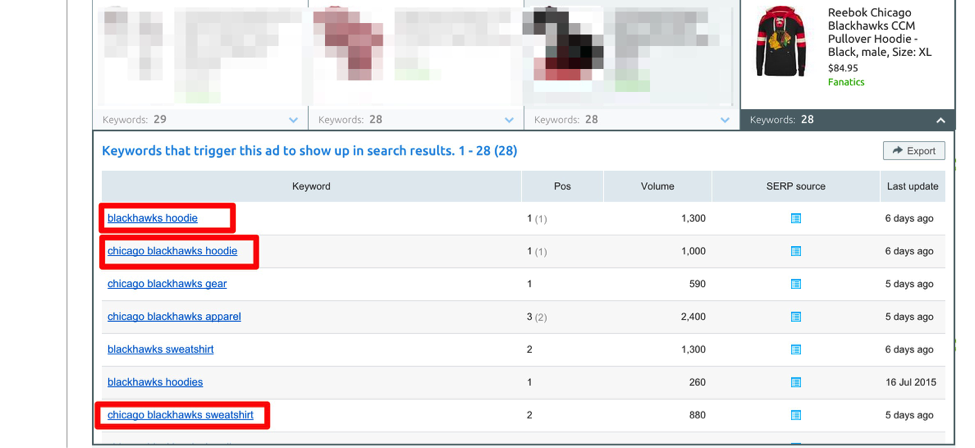
3. Image Comparison
Google is picky about your images, and with good reason. They want to create consistency for the platform and prevent advertisers from getting gimmicky with logos, watermarks, and promotional text.
Your product image has to be just that – an image of the product. White background. No logos (unless they are on the product). Easily visible in thumbnail size. Ultimately, think clicks here.
Your image is often the first thing to grab attention. A quick second is price, but image usually is the first to catch a shopper’s eye. Does your image show your product from the best angle? Is the lighting right? Can shoppers easily see what they need to see? Look at your competitors' images in SEMrush and see how your images stack up.
4. Description Hacking
Your product descriptions do not need to be lengthy. You get no extra points for good prose or persuasive copy (almost no one except Google will see your descriptions anyway). Just continue describing the product. Take your title, reorder it, and add in other attributes that wouldn’t fit in the title. Look at the descriptions from your top competition and pay attention to order and make up. Look at the PLA copies in SEMrush and find a similar product listing ad from your competitors.
In SEMrush under PLA copies, click on the keywords drop down and see what other keywords this product ranks for. If they rank for something that isn't in the title, then it’s likely in the description. While you would never add words like “cheap” or “discount” or “wholesale” to a product title, you could possibly add those to a description.
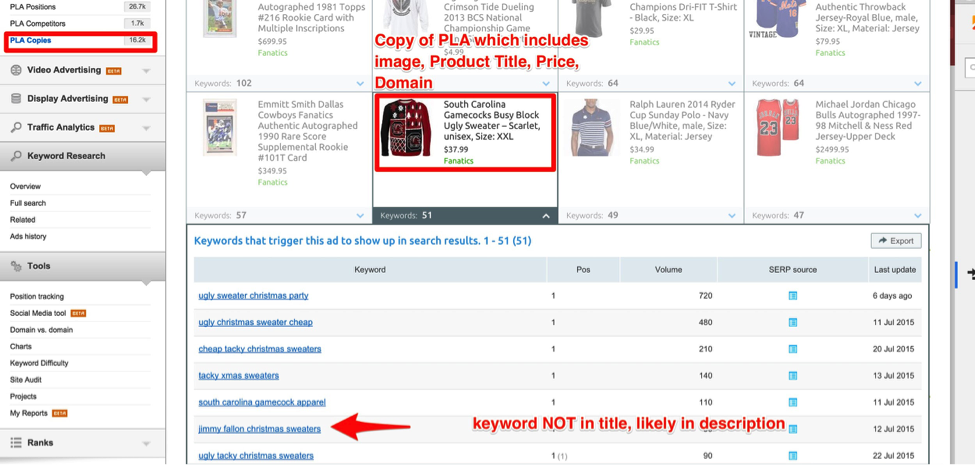
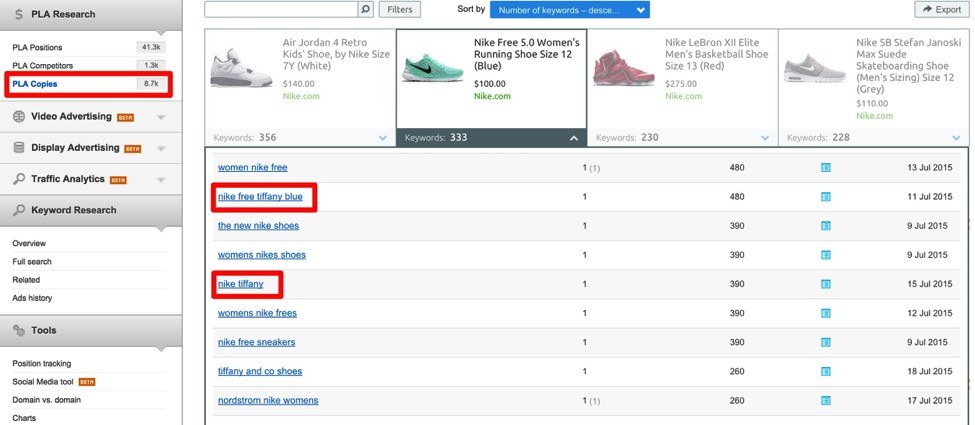
Grow Profitably
5. Smart Bidding
Think price, profits, and potential. Aside from feed quality and makeup, your bidding strategy is what will determine your overall sales volume and profitability with Google Shopping. Bidding has a direct correlation to the keywords you’ll show up for. As you are setting your bids consider the following:
Price
What’s the sales price of an item? If your product retails for $6, then a starting bid of $3 isn’t going to work. How many clicks would you need before you make a sale? If the answer is more than 2 (and it almost certainly is) then you need to rethink your bid.
Profit
What is your margin like on a group of products? You might not think you would bid the same on a $50 product as you would a $100 product unless you knew that the $50 product had a 50% margin and the $100 product had a 25% margin. In that case you would have the same available profit to advertise either item.
Potential
Maybe you have a strategic reason to bid more aggressively on a product than the price and profit might warrant. Say you are launching a new product and you want it to show up for all kinds of broad category search terms. Or maybe an item is a consumable and leads to regular orders or to customers with a high lifetime value. Bidding higher on these products might make perfect sense.
How will you structure your campaign to make bidding easier?
One reason most companies don’t bid properly on their products is that they haven’t made it easy to segment and make the changes that need to be made. The first step is segmenting your products into product groups that make sense from a monitoring and optimization standpoint. Just like a coach wants to observe each player, check numbers, and make changes to the starting lineup or playing time, you need to be able to have a clear picture of product performance. Without proper product grouping this becomes almost impossible.
Brand
Grouping products by brand can be a decent start, but likely it won’t be enough. What if you have products from the same brand that sell for $10 and $250 dollars? You wouldn’t want to bid the same on these.
Category
Grouping products by their category is also a decent start but often too broad. Consider adding custom labels by price point, seasonality, top sellers, etc.
Ideally you want to choose a product grouping strategy that will get your products in a place where you can create unique bids on a SKU level. So maybe you start with brand or category, then you segment by custom label for price range, then you look at individual SKUs in that group.
Looking at performance by SKU and creating unique bids by SKU gives you the most control over your account. At a minimum you want tightly formed product groups with products that warrant similar bids.
Remember that with Google Shopping (like with most digital marketing) success is a matter of stacking a lot of little things together in the right way. If you start to get bogged down in the details, remember the potential pay off. Understand that working on your data, your campaign structure and your bids is really all about getting your products in front of the right prospects and giving you control. There aren’t many ad platforms that consistently generate 6 to 1 returns. In my opinion, time spent with Google Shopping is time well spent.
Have you had successful experiences with Google Shopping? Please let us know in the comments!
Join My Webinar
Want to learn more about Google Shopping strategies? Join me with SEMrush on our upcoming webinar " Your Ultimate Path to Google Shopping Success," on Thursday, August 6, 2015. See the registration page to sign up and check the local time.
